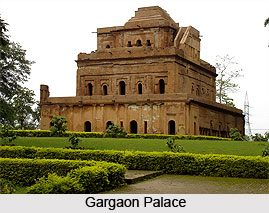 Suremphaa ruled over the Ahom kingdom from 1751 to 1769 AD. He was also known as Swargadeo Rajeswar Singha and was the fourth son of the Ahom king Rudra Singha. He succeeded the throne after the death of King Pramatta Singha, his elder brother. The third son of Rudra Singha could not become the king as he had smallpox marks on his face and as per Ahom tradition, the Ahom king should be free from any physical disability. Coronation of Suremphaa followed usual ceremonies. After becoming the king he firstly sent his brother Mohanmala Gohain to exile.
Suremphaa ruled over the Ahom kingdom from 1751 to 1769 AD. He was also known as Swargadeo Rajeswar Singha and was the fourth son of the Ahom king Rudra Singha. He succeeded the throne after the death of King Pramatta Singha, his elder brother. The third son of Rudra Singha could not become the king as he had smallpox marks on his face and as per Ahom tradition, the Ahom king should be free from any physical disability. Coronation of Suremphaa followed usual ceremonies. After becoming the king he firstly sent his brother Mohanmala Gohain to exile.
Administration of Suremphaa
The administration of Suremphaa was strong but he used to pay less attention to the state affairs. Bakatial Gendhela Borbarua of his kingdom looked after the state administration after the expedition of Manipur. The arrogance of Bakatial however made him unpopular among the other nobles of the kingdom and paved way for his assassination plans. But the folks of Ahom kingdom during the reign of Suremphaa were blessed with peace and prosperity. Internal affairs of the kingdom were ordered and the army was able enough to suppress any external aggression. Nevertheless a little indiscipline prevailed as the senior officers often refused to take up assigned services. Preachers and priests had divided the Ahoms in sectarian lines. During his reign there was a dispute between the Hindu astrologers and the Deodhais, who were the Ahom priests, regarding the location of capital. The former recommended Rangpur whereas the latter recommended Taimung. Taking the advice of Hindu astrologers, Suremphaa established his palace at Rangpur. However, later he built another palace at Taimung too. Both the brick buildings were massive.
Expeditions of Suremphaa
In 1758, a conflict occurred with the Dafla owing to their raids on the people of the plains near Ghiladhari. Forts were built in the frontiers for prohibiting the entry of Daflas in the plains. Afterwards an agreement was made between the Ahoms and the Daflas according to which the Daflas were allowed to collect paddy without causing any aggression in the kingdom. Similar preventive measures were also taken against the Mikirs in July 1765. Ahom forces invaded the Kopili and Jamuna rivers and returned with begged forgiveness of Mikirs by defeating them.
During the rule of Suremphaa, Jai Singh of Manipur once appealed the Ahom king for helping him against the Burmese invasion. After consultation with his ministers, Suremphaa sent his army for an expedition against the Burmese in the Manipur territory. On the way, the army encountered great hardships and many died owing to lack of food and snake bites. Thus the king called off the expedition which later became popular as "Lotakota ron". Later in the year 1768 another army was sent for the same cause through a different route under the commandership of Bakatial Gendhela Borbarua. After defeating the Burmese, Jai Singh sent precious gifts to Suremphaa and also got his daughter, Kuranganayani, married to the king. Kuranganayani later became the chief queen of Suremphaa.
Religious Contributions of Suremphaa
Suremphaa followed Hindu religion and thus also built a number of temples in the kingdom. He also presented a large portion of land to Brahmins. After his coronation he also paid visit to the Kamakhya and other temples of Guwahati and became the disciple of Nati Gosain who was the relative of the head priest of Kamakhya temple, Parbatiya Gosain. In the year 1759 he presented to the Basudeb temple situated near Nalbari, 64 bighas of land. The temple was built by Siba Singha and annual grand celebrations of Janmastami and Doul Jatra takes place in this temple. Suremphaa also built the Manikarnesvaar temple in 1755 for promoting the Saiva cult. He also established the Siddhesvara temple at Sualkuchi in the year 1764 and in 1759 he made financial provision for the Sukreswar temple. At the Citrasala hill of Guwahati, the Navagraha temple was also built by Suremphaa.
Civil Works of Suremphaa
Suremphaa constructed a number of temples during his reign. Apart from this, his most prominent contribution includes the renovation of Garhgaon palace by adding three underground storeys to it known as Talatal Ghar. It had two secret underground tunnels which connect with Dikhow River. In case of enemy attack the palace was used as an escape route. He also constructed the Borbheti Than near Jorhat town. After suffering from a serious illness of twenty days, Suremphaa died in the year 1769.



















